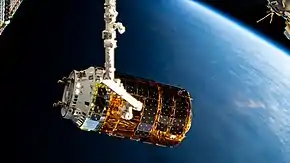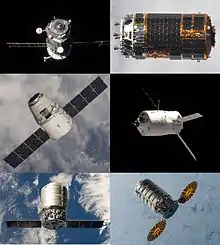 H-II Transfer Vehicle (HTV-8) being grappled by the Canadarm2 on 1 November 2019. | |
| Mission type | ISS resupply |
|---|---|
| Operator | JAXA |
| COSPAR ID | 2019-062A |
| SATCAT no. | 44546 |
| Mission duration | 40 days |
| Spacecraft properties | |
| Spacecraft | Kounotori 8 |
| Spacecraft type | HTV |
| Manufacturer | Mitsubishi Heavy Industries |
| Launch mass | 15800 kg [1] |
| Dry mass | 10500 kg |
| Payload mass | 5300 kg |
| Dimensions | 9.8 metre of long, 4.4 metre of diameter |
| Start of mission | |
| Launch date | 24 September 2019, 16:05:05 UTC[2] |
| Rocket | H-IIB No. 8 |
| Launch site | Tanegashima, Yoshinobu-2 |
| Contractor | Mitsubishi Heavy Industries |
| End of mission | |
| Disposal | Deorbited |
| Decay date | 3 November 2019 |
| Orbital parameters | |
| Reference system | Geocentric orbit |
| Regime | Low Earth orbit |
| Inclination | 51.66° |
| Berthing at ISS | |
| Berthing port | Harmony nadir |
| RMS capture | 28 September 2019, 11:12 UTC [3] |
| Berthing date | 28 September 2019, 14:09 UTC [4] |
| Unberthing date | 1 November 2019, 13:45 UTC [5] |
| RMS release | 1 November 2019, 17:21 UTC [6][7] |
| Time berthed | 34 days |
| Cargo | |
| Mass | 5300 kg |
| Pressurised | 3400 kg |
| Unpressurised | 1900 kg |
Kounotori 8 (こうのとり8号機), also known as HTV-8 was the 8th flight of the H-II Transfer Vehicle, a robotic cargo spacecraft to resupply the International Space Station. It was launched on 24 September 2019, 16:05:05 UTC.[8]
Spacecraft
Major changes from previous Kounotori are:[9]
- Replacement of Earth sensor with star tracker for spacecraft attitude control
- New cargo racks developed for HTV-X which allows 30% more Cargo Transfer Bags (CTB) to be carried in the Pressurized Logistics Carrier (PLC). (316 CTBs for Kounotori 8, compared to 248 CTBs of Kounotori 6)
Cargo
Kounotori 8 carries about 5300 kg of cargo, consisting of 3400 kg in the pressurized compartment and 1900 kg in the unpressurized compartment.[9]
Cargo in the Pressurized Logistics Carrier (PLC) include:[9]
- JAXA experiment Cell Biology Experiment Facility-Left (CBEF-L)
- JAXA experiment Sony Optical Link for ISS (SOLISS), a satellite optical communication demonstration co-developed with Sony Computer Science Laboratories
- JAXA experiment Hourglass, which will investigate the behavior of soil and rock particles under low gravity conditions[10]
- Gas bottle for JAXA experiment
- Experiment materials for Electrostatic Levitation Furnace (ELF)
- CubeSats to be deployed from ISS: NARSSCube-1, AQT-D, RWASAT-1
- NASA system supply cargo: new water tank for Water Storage System (WSS)
- NASA system supply cargo: tank for Nitrogen Oxygen Recharge System (NORS)
In the Unpressurized Logistics Carrier (ULC), Kounotori 8 carries six lithium-ion batteries Orbital Replacement Units (ORUs) for replacing the ISS's existing nickel-hydrogen batteries. The transportation of replacement batteries is a continuation from the previous Kounotori 6 and 7, and will continue through to Kounotori 9.[9]
Operation
Launch
The H-IIB launch vehicle carrying Kounotori 8 was initially scheduled to be launched at 21:33:29 UTC, 10 September 2019.[11][12] During launch preparation, a fire broke out at the launch pad at around 18:05 UTC (T minus 3.5 hours), and the launch was called off.[13] The cause of fire was attributed to the static electricity on the heat resistant material under the mixture of liquid oxygen and gas oxygen for the engine pre-cooling.[14]
After the modification to the mobile launch platform to suppress static electricity, a new launch was scheduled at 23 September 2019, 16:30 UTC,[14] but the collision avoidance check revealed that the 2nd stage of the launch vehicle might approach near the Soyuz MS-15 which was scheduled to be launched on 25 September 2019. A revised launch schedule was set for 16:05 UTC, 24 September 2019.[15] On 24 September 2019, 16:05:05 UTC, the Kounotori 8 aboard H-IIB was launched successfully.[8]
Operation while berthed to the ISS
Kounotori 8 was captured by the Space Station Remote Manipulator System (SSRMS) at 23:13 UTC, on 27 September 2019,[16] and berthed at Harmony's nadir Common Berthing Mechanism (CBM) by 17:55 UTC, on 28 September 2019.[17]
The External Palette (EP8), which carries the lithium-ion battery Orbital Replacement Units (ORU), was extracted from the Kounotori 8's Unpressurized Logistics Carrier (ULC) by the SSRMS (Canadarm2) on 29 September 2019.[18]
The External Palette of Kounotori 7 (EP7) was placed in the Kounotori 8's ULC.[19] EP7 was left on the ISS after the departure of Kounotori 7 due to the schedule change of extravehicular activity after the launch failure of Soyuz MS-10.
Departure and reentry to the Earth atmosphere
On 1 November 2019, Kounotori 8 was detached from Harmony's CBM by the SSRMS (Canadarm2), and it was released into orbit at 17:20 UTC.[20]
It was disposed by the destructive reentry to the Earth atmosphere at around 02:09 UTC, on 3 November 2019.[21]
References
- ↑ https://nssdc.gsfc.nasa.gov/nmc/spacecraft/display.action?id=2019-062A - 14 May 2020 - 20 May 2020
 This article incorporates text from this source, which is in the public domain.
This article incorporates text from this source, which is in the public domain. - ↑ Live coverage: Japanese cargo freighter set for launch to ISS
- ↑ ISS: Expedition 60
- ↑ Japan's Kounotori Spaceship Attached to Station Archived 19 September 2021 at the Wayback Machine
 This article incorporates text from this source, which is in the public domain.
This article incorporates text from this source, which is in the public domain. - ↑ "Kounotori 8 was unberthed of Harmony". iss.jaxa.jp. JAXA. 1 November 2019. Retrieved 10 November 2019.
- ↑ @planet4589 (1 November 2019). "Aboard ISS, Japanese cargo ship HTV-8 was unberthed around 1230 UTC and released into orbit at 17:21 UTC. HTV-8 will carry out destructive deorbit over the South Pacific tomorrow night" (Tweet) – via Twitter.
- ↑ Expedition 61
- 1 2 "Launch Result of the H-II Transfer Vehicle Kounotori 8 aboard the H-IIB Vehicle No. 8". Mitsubishi Heavy Industries. 25 September 2019. Retrieved 25 September 2019.
- 1 2 3 4 "宇宙ステーション補給機「こうのとり」8号機(HTV8)【ミッションプレスキット】" (PDF) (in Japanese). JAXA. 30 August 2019. Archived from the original (PDF) on 29 November 2020. Retrieved 3 September 2019.
- ↑ "JAXA to launch eighth HTV space station cargo mission in September". Spaceflight Now.
- ↑ "Launch Schedule of the H-II Transfer Vehicle Kounotori 8 aboard the H-IIB Vehicle No. 8". Mitsubishi Heavy Industries. 29 July 2019. Retrieved 12 September 2019.
- ↑ "Launch Time of the H-II Transfer Vehicle Kounotori 8 aboard the H-IIB Vehicle No. 8". Mitsubishi Heavy Industries. 9 September 2019. Retrieved 12 September 2019.
- ↑ "Launch Canceled, H-II Transfer Vehicle Kounotori 8 aboard the H-IIB Vehicle No. 8". Mitsubishi Heavy Industries. 11 September 2019. Retrieved 12 September 2019.
- 1 2 "Updated Launch Schedule of the H-II Transfer Vehicle Kounotori 8 aboard the H-IIB Vehicle No. 8". Mitsubishi Heavy Industries. 20 September 2019. Retrieved 25 September 2019.
- ↑ "Updated Launch Schedule of the H-II Transfer Vehicle Kounotori 8 aboard the H-IIB Vehicle No. 8". Mitsubishi Heavy Industries. 21 September 2019. Retrieved 25 September 2019.
- ↑ 「こうのとり」8号機がSSRMSに把持されました (in Japanese). JAXA. 28 September 2019. Retrieved 3 October 2019.
- ↑ 「こうのとり」8号機、ISSとの結合完了! (in Japanese). JAXA. 29 September 2019. Retrieved 3 October 2019.
- ↑ 曝露パレットの収納完了 (in Japanese). JAXA. 1 October 2019. Retrieved 3 October 2019.
- ↑ Keeter, Bill (1 October 2019). "ISS Daily Summary Report – 10/01/2019". ISS On-Orbit Status Report. NASA. Retrieved 3 October 2019.
 This article incorporates text from this source, which is in the public domain.
This article incorporates text from this source, which is in the public domain. - ↑ "Kounotori 8 Leaves the ISS". JAXA. 2 November 2019. Retrieved 6 November 2019.
- ↑ "Successful re-entry of H-II Transfer Vehicle "Kounotori 8" (HTV-8)". JAXA. 3 November 2019. Retrieved 6 November 2019.
External links
- JAXA HTV page Archived 14 October 2013 at the Wayback Machine
